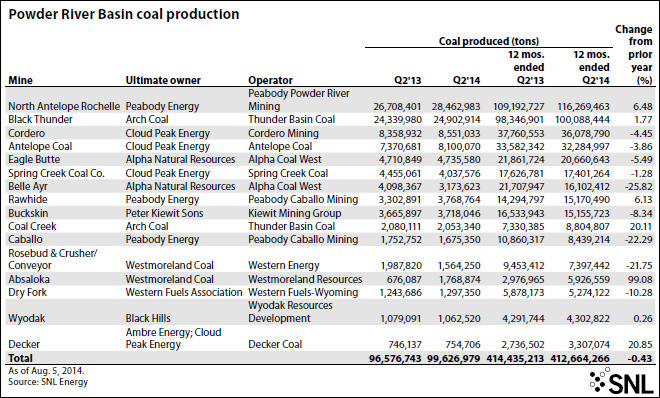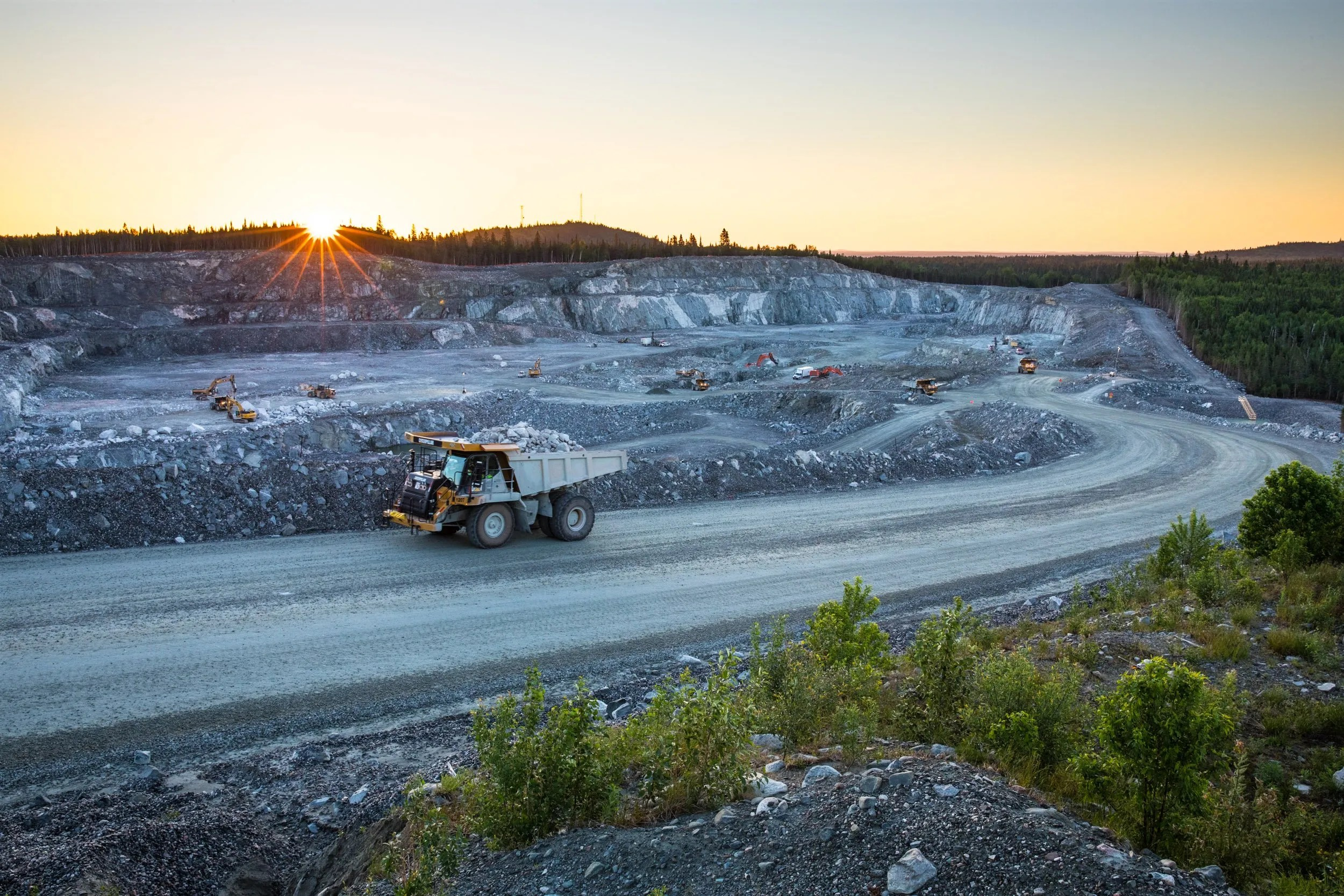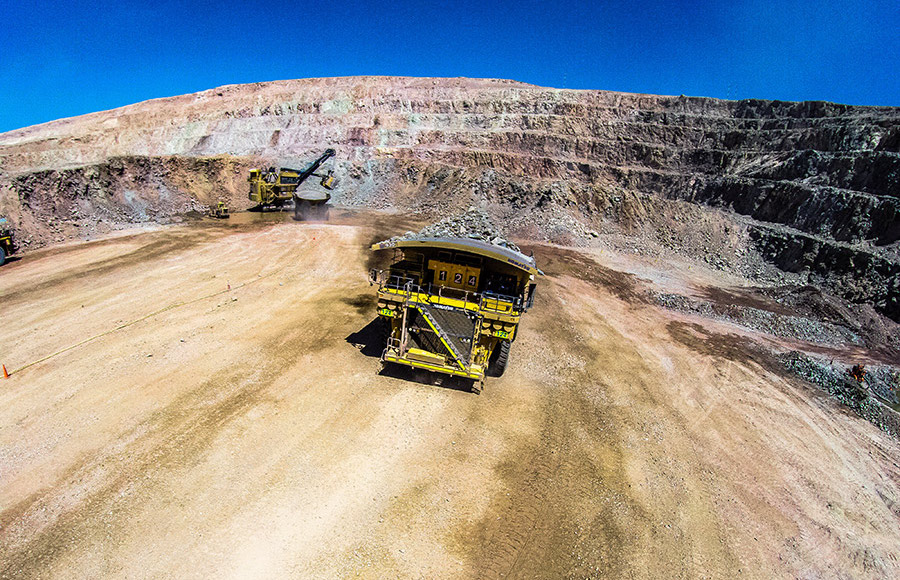Top-producing Powder River Basin coal mines in Q2’14
Production from the largest active Powder River Basin coal mines totaled 99.63 million tons in the second quarter, according to an SNL Energy analysis of U.S. Mine Safety and Health Administration data, down from the previous quarter as railroad transportation issues stymied demand.
First-quarter production from the PRB mines totaled 101.17 million tons. The second-quarter production total represented a 3.2% increase over the 96.58 million tons produced in the second quarter of 2013.
Ten of the 16 PRB mines reported higher production in the second quarter than the year-ago quarter. Production from the mines in the 12 months ended in the second quarter totaled 412.66 million tons, down 0.4% from the 414.44 million tons produced in the year-ago period.

A shift away from 8,400 Btu/lb coal is taking place in the PRB as coal producers focus their capital expenditures on developing their higher-quality, 8,800 Btu/lb mines. Cloud Peak Energy Inc.‘s Cordero Rojo mine, which produces 8,423 Btu/lb coal, produced 36.08 million tons in the 12 months ended in the second quarter, down 4.5% compared to the year-ago period. Cloud Peak is reducing production at Cordero Rojo by about 10 million tons per year starting in 2015.
According to SNL Energy over-the-counter market survey data, 2015 PRB 8,800 Btu/lb coal was priced at $12.62/ton as of Aug. 5. The 2015 8,400 Btu/lb coal product was priced at $10.14/ton.
“There is quite a spread at the moment,” Cloud Peak President and CEO Colin Marshall said during the company’s second-quarter earnings call July 29. “I’d look at it and say, Well, I’m glad we’re not trying to sell those tons into next year because I think at the moment the prices aren’t that attractive. So, it reinforces why we made the decision [to cut production at Cordero Rojo], and we think that being able to deploy those assets to the dragline and some other assets around the business will give us the best return.”
Marshall said Cloud Peak is benefiting from the plans to cascade equipment from Cordero Rojo to the other mine sites. The company spent just $2.6 million in capital expenditures in the second quarter, almost entirely associated with ensuring the ongoing integrity of its existing equipment.
Peabody Energy Corp.‘s Caballo mine, which produces 8,500 Btu/lb coal, also has seen production totals decline. The mine, which produced 24.14 million tons in 2011, has only produced 3.46 million tons in the first half of 2014. Caballo production in the 12 months ended in the second quarter totaled 8.44 million tons, down 22.3% from the 10.86 million tons produced in the year-ago period.
Alpha Natural Resources Inc.‘s Belle Ayr mine, which produces 8,550 Btu/lb coal, produced 16.10 million tons in the 12 months ended in the second quarter, down 25.82% from the 21.71 million tons produced in the year-ago period.
The mines boosting production in the second quarter include Peabody’s North Antelope Rochelle operation, Cloud Peak’s Antelope mine and Westmoreland Coal Co.‘s Absaloka mine. North Antelope, the highest-producing mine in the U.S., produced 28.46 million tons in the second quarter, up 6.6% from the 26.71 million tons produced in the year-ago quarter. Peabody also increased quarterly production year over year at its Rawhide mine in Wyoming during the quarter.
Westmoreland’s Absaloka mine, buoyed by a new deal with TransAlta Centralia Generation and a newly constructed rail wye, saw production soar in the second quarter compared to the year-ago quarter despite continued rail transportation woes.
The transportation issue is likely to last into 2015, possibly weighing on PRB production totals for the remainder of the year. Some utilities are still not receivingtheir normal shipments, and several coal executives, including at Arch Coal Inc. and Cloud Peak, said rail performance was far from optimal in June and July.
“The rail performance represents the largest risk to our business,” Marshall said. “The tons are sold, the customers certainly have very low stockpiles and would like to take delivery, and the mines are in good shape. We would very much like to deliver that coal in the second half and certainly as much as possible.”
More News
Sayona-Piedmont merger forms Elevra Lithium with equal board representation
The merger is expected to be completed in mid-2025.
April 10, 2025 | 06:54 am
Codelco logging strong Q2 demand from China, chairman says
April 10, 2025 | 06:50 am
{{ commodity.name }}
{{ post.title }}
{{ post.date }}




Comments